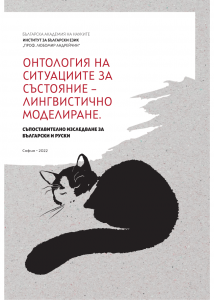Предикаты состояния и семантические типы предикатов
States, events and predicate types
Author(s): Anton Zimmerling
Subject(s): Language studies, Language and Literature Studies, Applied Linguistics, Morphology, Syntax, Semantics, Comparative Linguistics, Cognitive linguistics, Descriptive linguistics, Eastern Slavic Languages, Phraseology
Published by: Институт за български език „Проф. Любомир Андрейчин“, Българска академия на науките
Keywords: predicate ontologies; states of affairs; eventualities; events; spatiotemporality; atemporality; Davidsonian states; properties; facts
Summary/Abstract: I discuss the foundations of predicate ontologies as grounded in two model notions – elementary states of affairs and events or eventualities, i.e. ordered pairs of initial and end states of affairs. Vendlerian classifications are oriented towards elementary states and tense logic, while Davidsonian classifications deal with eventualities and event logic. Most existing approaches implement two taxonomic criteria: 1) a distinction between spatiotemporal and non-spatiotemporal (atemporal) predicates; 2) a distinction between dynamic and static predicates. There are two kinds of atemporal meanings – predication of facts and predication of properties. Facts are propositional arguments of second-order predicates which add a special meaning that the embedded proposition has been verified. Properties are atemporal first-order predicates that lack an eventive interpretation and are not associated with factive frames. Davidsonian states are homogeneous durable spatiotemporal entities distinct both from atemporal properties and spatiotemporal dynamic predicates. The homogeneity criterion differentiates Davidsonian states from telic dynamic predicates denoting a transition from phase p to phase ~ p. The durability criterion distinguishes Davidsonian states from accomplishments (i.e. resultatives) that are anchored to a single time point. Davidsonian states are conceptualized in natural language metaphysics as causally independent entities,while resultatives are causally determined as they reconstruct a preceding event that has caused the end state p. The demarcation line between Davidsonian states and homogeneous atelic processes depends on the chosen criteria for identification of active and inactive (inert)processes. It is usually assumed that Davidsonian states do not combine with active subjects.The subcategorization of Davidsonian states must be based on their quantification properties.I discuss the contrast between external and internal Davidsonian states. The former lack a priority argument and may be quantified extensionally based on their locus parameters, e.g.time and space. The latter have a priority experiential argument and can only be quantified intensionally. External states can be observed, while internal states cannot be observed and visualized. The stage-level-predicate (SLP) vs. individual-level predicate (ILP) distinction introduced by Carlson is equivalent to the one between Davidsonian states and properties in holistic predicate ontologies, but Carlson’s approach patterns with partial ontologies, i.e.the manifestation of categorial predicate types in diagnostic syntactic contexts. A similar approach has been developed by Shcherba, who claimed that <Davidsonian> states opposed to properties tend to form a word class consisting of non-agreeing non-verbal expressions in Modern RussianI discuss the foundations of predicate ontologies as grounded in two model notions – elementary states of affairs and events or eventualities, i.e. ordered pairs of initial and end states of affairs. Vendlerian classifications are oriented towards elementary states and tense logic, while Davidsonian classifications deal with eventualities and event logic. Most existing approaches implement two taxonomic criteria: 1) a distinction between spatiotemporal and non-spatiotemporal (atemporal) predicates; 2) a distinction between dynamic and static Предикаты состояния... 52 predicates. There are two kinds of atemporal meanings – predication of facts and predication of properties. Facts are propositional arguments of second-order predicates which add a special meaning that the embedded proposition has been verified. Properties are atemporal first-order predicates that lack an eventive interpretation and are not associated with factive frames. Davidsonian states are homogeneous durable spatiotemporal entities distinct both from atemporal properties and spatiotemporal dynamic predicates. The homogeneity criterion differentiates Davidsonian states from telic dynamic predicates denoting a transition from phase p to phase ~ p. The durability criterion distinguishes Davidsonian states from accomplishments (i.e. resultatives) that are anchored to a single time point. Davidsonian states are conceptualized in natural language metaphysics as causally independent entities, while resultatives are causally determined as they reconstruct a preceding event that has caused the end state p. The demarcation line between Davidsonian states and homogeneous atelic processes depends on the chosen criteria for identification of active and inactive (inert) processes. It is usually assumed that Davidsonian states do not combine with active subjects. The subcategorization of Davidsonian states must be based on their quantification properties. I discuss the contrast between external and internal Davidsonian states. The former lack a priority argument and may be quantified extensionally based on their locus parameters, e.g. time and space. The latter have a priority experiential argument and can only be quantified intensionally. External states can be observed, while internal states cannot be observed and visualized. The stage-level-predicate (SLP) vs. individual-level predicate (ILP) distinction introduced by Carlson is equivalent to the one between Davidsonian states and properties in holistic predicate ontologies, but Carlson’s approach patterns with partial ontologies, i.e. the manifestation of categorial predicate types in diagnostic syntactic contexts. A similar approach has been developed by Shcherba, who claimed that
- Page Range: 31-52
- Page Count: 22
- Publication Year: 2022
- Language: Russian
- Content File-PDF

